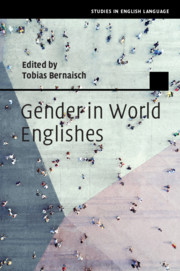Book contents
- Gender in World Englishes
- Studies in English Language
- Gender in World Englishes
- Copyright page
- Dedication
- Contents
- Figures
- Tables
- Contributors
- Chapter 1 Introduction
- Chapter 2 Localisation, Globalisation and Gender in Discourse-Pragmatic Variation in Ghanaian English
- Chapter 3 Sociolinguistic Variation in Intensifier Usage in Indian and British English
- Chapter 4 Tag Questions and Gender in Indian English
- Chapter 5 Hedges and Gender in the Inner and Expanding Circle
- Chapter 6 The Role of Gender in Postcolonial Syntactic Choice-Making
- Chapter 7 Social Constraints on Syntactic Variation
- Chapter 8 Linguistic Colloquialisation, Democratisation and Gender in Asian Englishes
- Chapter 9 Gender, Writing and Editing in South African Englishes
- Index
- References
Chapter 1 - Introduction
Genderlectal Variation in the English-Speaking World
Published online by Cambridge University Press: 11 December 2020
- Gender in World Englishes
- Studies in English Language
- Gender in World Englishes
- Copyright page
- Dedication
- Contents
- Figures
- Tables
- Contributors
- Chapter 1 Introduction
- Chapter 2 Localisation, Globalisation and Gender in Discourse-Pragmatic Variation in Ghanaian English
- Chapter 3 Sociolinguistic Variation in Intensifier Usage in Indian and British English
- Chapter 4 Tag Questions and Gender in Indian English
- Chapter 5 Hedges and Gender in the Inner and Expanding Circle
- Chapter 6 The Role of Gender in Postcolonial Syntactic Choice-Making
- Chapter 7 Social Constraints on Syntactic Variation
- Chapter 8 Linguistic Colloquialisation, Democratisation and Gender in Asian Englishes
- Chapter 9 Gender, Writing and Editing in South African Englishes
- Index
- References
Summary
Setting the agenda for the volume, this introduction amalgamates the so far relatively isolated strands of research into genderlectal variation and World Englishes, relying on state-of-the-art empirical approaches. As they apply to the vast majority of speakers of English around the world, the notions of English as a second language and English as a foreign language are introduced and – in this light – recent attempts at bridging this paradigm gap between these two speaker groups as well as the models employed in these attempts are briefly discussed. For the study of gender and language, the central pillars of its most prominent theoretical waves – the dominance, the difference and the social construct framework – are presented and the corresponding methodological approaches critically appraised. Against this background, it is concluded that responsible explorations of genderlectal variation in World Englishes need to be based on transparent empirical foundations – both in terms of datasets and statistical modelling. For this reason, the tenets of corpus linguistics are explored and the benefits of multifactorial statistical techniques as consistently applied in this volume are illustrated. After previews of the individual chapters in the volume, the introduction ends with summarising remarks including the moderator function of gender in World Englishes.
Keywords
- Type
- Chapter
- Information
- Gender in World Englishes , pp. 1 - 22Publisher: Cambridge University PressPrint publication year: 2021



